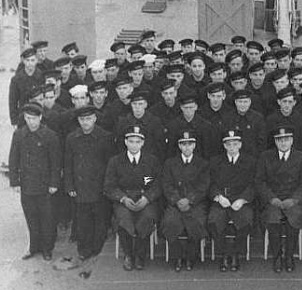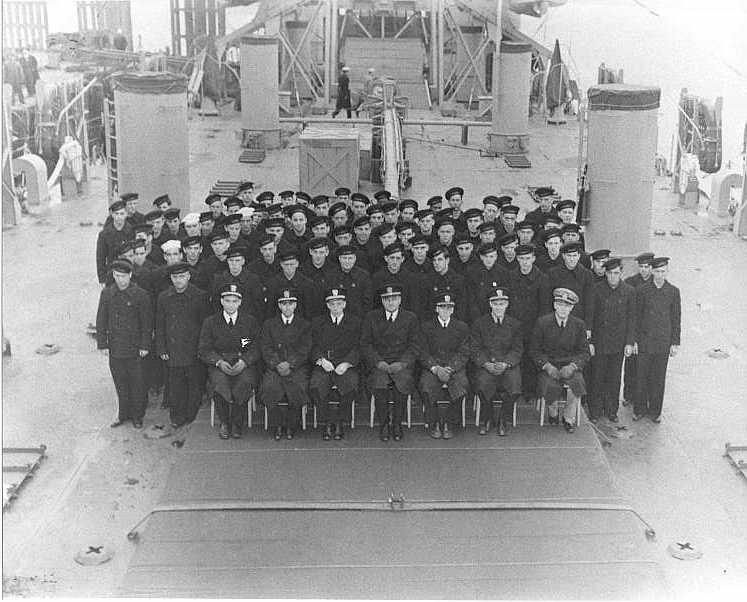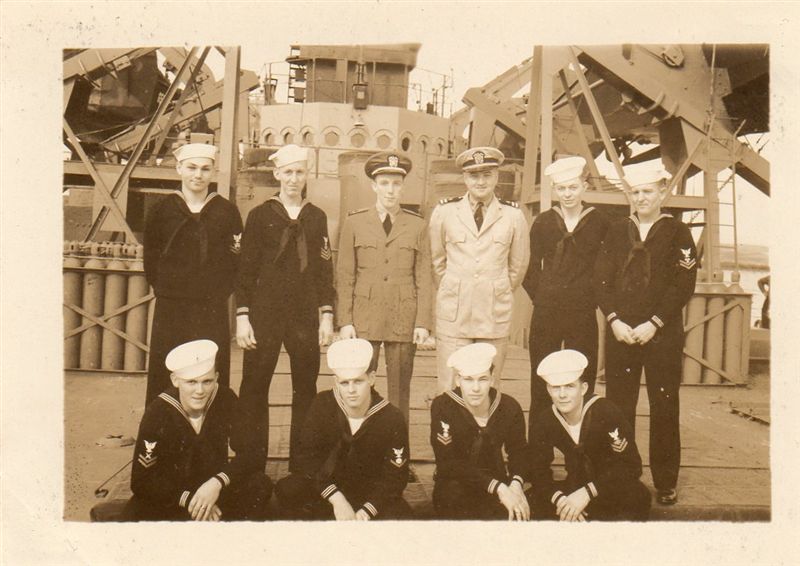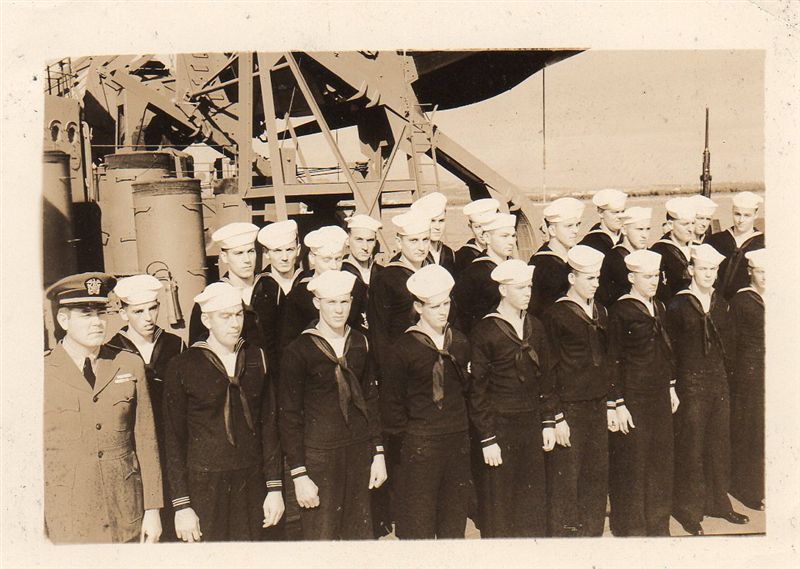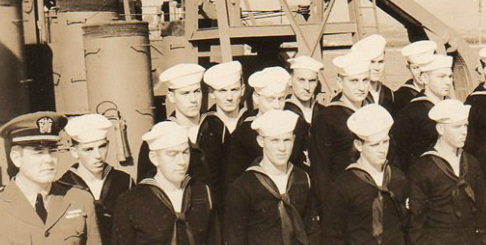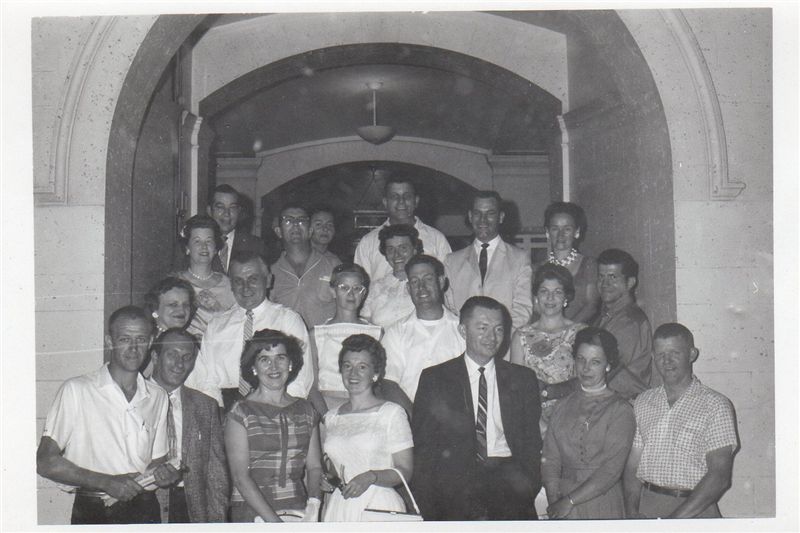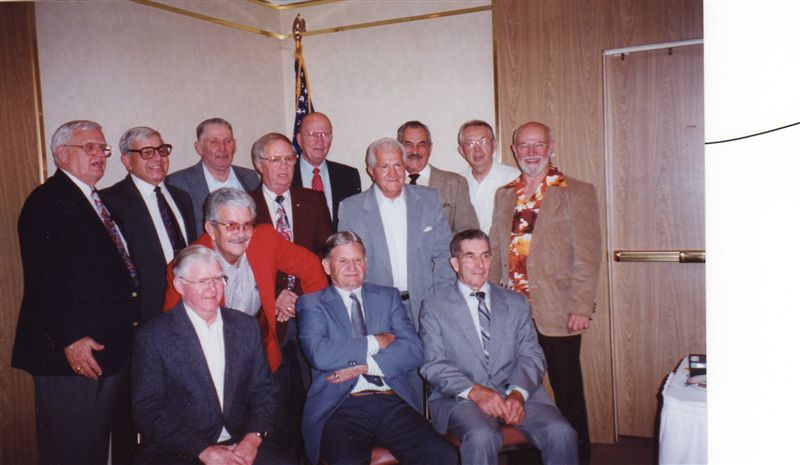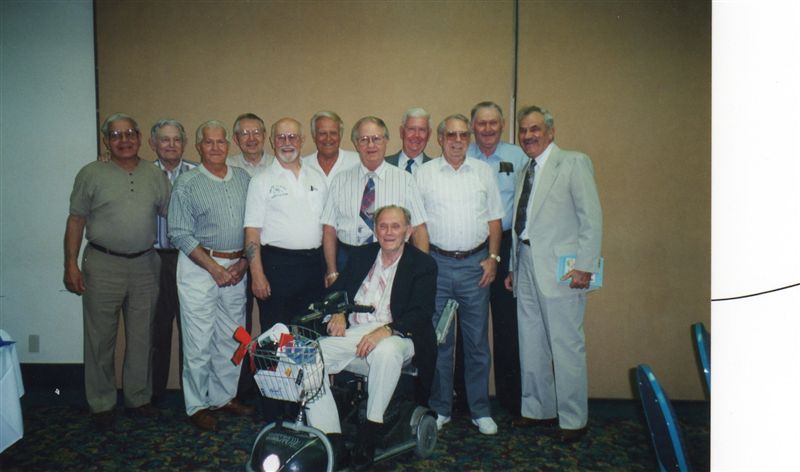USS LST 656
landing ship, tank (LST)
USS LST
naval ship specially designed to transport and deploy troops,
vehicles, and supplies onto foreign shores for the conduct of offensive military
operations. LSTs were designed during World War II to disembark military forces
without the use of dock facilities or the various cranes and lifts necessary to
unload merchant ships. They gave the Allies the ability to conduct amphibious
invasions at any location on a foreign shore that had a gradually sloped beach.
This ability permitted the Allies to assault poorly defended sectors, thereby
achieving operational surprise and, in some cases, even tactical surprise.
Specially designed landing ships were first employed by the
British in Operation Torch, the invasion of North Africa in 1942. The British
recognized the need for such ships after the debacle at Dunkirk in 1940, when
they left behind tons of badly needed equipment because no vessels were
available with the capability to bridge the gap between the sea and the land.
Following the evacuation, Prime Minister Winston Churchill sent his minister of
supply a memorandum posing the question, What is being done about
designing and planning vessels to transport tanks across the sea for a British
attack on enemy countries? These must be able to move six or seven hundred
vehicles in one voyage and land them on the beach, or, alternatively, take them
off the beaches.
As an interim measure, three shallow-draft tankers were converted
to LSTs. The bows were redesigned so that a door, hinged at the bottom, and a
68-foot- (21-metre-) long double ramp could be fitted to the vessels. These
modifications made it possible for vehicles to disembark directly from the ship
to the beach. Both the new design and the vessel were considered unsatisfactory,
but the concept was sound.
At the request of the British, the Americans undertook the
redesign and production of LSTs in November 1941, and John Niedermair of the
Bureau of Ships designed a ship with a large ballast system. Deep-draft ships
were necessary to cross the ocean, and shallow-draft vessels were required to
bridge the water gap. A newly proposed ballast system gave one ship both
capabilities: when at sea the LST took on water for stability, and during
landing operations the water was pumped out to produce a shallow-draft vessel.
The American-built LST Mk2, or LST(2), was 328 feet in length and 50 feet wide.
It could carry 2,100 tons. Built into the bow were two doors that opened
outward to a width of 14 feet. Most Allied vehicles could be transported on and
off-loaded from LST(2)s. The lower deck was the tank deck, where 20 Sherman
tanks could be loaded. Lighter vehicles were carried on the upper deck. An
elevator was used to load and off-load vehicles, artillery, and other equipment
from the upper deck; in later models a ramp replaced the elevator. The vessel
was powered by two diesel engines, and it had a maximum speed of 11.5 knots and
a cruising speed of 8.75 knots. LSTs were lightly armed with a variety of
weapons. A typical American LST was armed with seven 40-mm and twelve 20-mm
antiaircraft guns.
The first mass-produced American LST, the LST-1, was commissioned
on December 14, 1942. A total of 1,051 LST(2)s were produced in American
shipyards during the war. Construction time declined so that by 1945 it took
approximately two months to construct an LST—half the time it took in 1943.
Through lend-lease the British were provided with 113 LST(2)s. LSTs were in
great demand in both the Pacific and Europe. They were used in the invasions of
Sicily, Italy, Normandy, and southern France. At Normandy the Americans'
employment of LSTs enabled them to meet their off-loading requirements
following the destruction of their Mulberry artificial harbour in a storm. In
the Southwest Pacific theatre, General Douglas MacArthur employed LSTs in his
“island-hopping campaigns” and in the invasion of the Philippines. In the
Central Pacific, Admiral Chester Nimitz used them at Iwo Jima and Okinawa.
LST(2)s served as troop ships, ammunition ships, hospital ships, repair ships,
and numerous other special-purpose vessels. A number of LST(2)s were even
fitted with flight decks for small reconnaissance aircraft. During the war, 26
LSTs were lost in action, and 13 more were lost in accidents and rough
seas.
Numerous other types of landing ships were produced by the
British and Americans during the war. Examples are the Landing Ship, Infantry
(Large), or LSI(L), named Auxiliary Personnel Attack Ship (APA) by the U.S.
Navy; the Landing Ship, Headquarters, or LSH, named Command Ship by the U.S.
Navy; the Landing Ship, Dock, or LSD; and the Landing Ship, Medium, or LSM.
Some vessels called “landing ships” did not have the capability to off-load
troops and supplies onto beaches; they were in fact simply transports or
command-and-control vessels.
During the Korean War, LSTs were employed in the Inch'ŏn landing.
Limited numbers of LSTs were produced in the 1950s and '60s. The most prominent
were the diesel-powered Newport LSTs, which were built for the U.S. Navy in the
1960s. These vessels displaced more than 8,000 tons fully loaded and transported
amphibious craft, tanks, and other combat vehicles, along with 400 men, at
speeds of up to 20 knots. Such speeds were made possible by abandoning the bow
doors of their World War II predecessors in favour of an extendable ramp
supported by huge projecting derrick extensions on each side of the bow. As the
ship beached, the ramp would shoot forward hydraulically 112 feet. Vehicles and
troops would land over the ramp, while amphibious craft in the tank deck would
disembark from stern gates.
Adrian R. Lewis
Encyclopedia Britannica
Additional Reading
Information on landing ships employed in World War II may be
found in Melvin D. Barger, Large Slow Target: A History of the LST, vol. 1
(1986); and Brian Macdermott, Ships Without Names: The Story of the Royal
Navy's Tank Landing Ships of World War Two (1992).
vehicles, and supplies onto foreign shores for the conduct of offensive military
operations. LSTs were designed during World War II to disembark military forces
without the use of dock facilities or the various cranes and lifts necessary to
unload merchant ships. They gave the Allies the ability to conduct amphibious
invasions at any location on a foreign shore that had a gradually sloped beach.
This ability permitted the Allies to assault poorly defended sectors, thereby
achieving operational surprise and, in some cases, even tactical surprise.
Specially designed landing ships were first employed by the
British in Operation Torch, the invasion of North Africa in 1942. The British
recognized the need for such ships after the debacle at Dunkirk in 1940, when
they left behind tons of badly needed equipment because no vessels were
available with the capability to bridge the gap between the sea and the land.
Following the evacuation, Prime Minister Winston Churchill sent his minister of
supply a memorandum posing the question, What is being done about
designing and planning vessels to transport tanks across the sea for a British
attack on enemy countries? These must be able to move six or seven hundred
vehicles in one voyage and land them on the beach, or, alternatively, take them
off the beaches.
As an interim measure, three shallow-draft tankers were converted
to LSTs. The bows were redesigned so that a door, hinged at the bottom, and a
68-foot- (21-metre-) long double ramp could be fitted to the vessels. These
modifications made it possible for vehicles to disembark directly from the ship
to the beach. Both the new design and the vessel were considered unsatisfactory,
but the concept was sound.
At the request of the British, the Americans undertook the
redesign and production of LSTs in November 1941, and John Niedermair of the
Bureau of Ships designed a ship with a large ballast system. Deep-draft ships
were necessary to cross the ocean, and shallow-draft vessels were required to
bridge the water gap. A newly proposed ballast system gave one ship both
capabilities: when at sea the LST took on water for stability, and during
landing operations the water was pumped out to produce a shallow-draft vessel.
The American-built LST Mk2, or LST(2), was 328 feet in length and 50 feet wide.
It could carry 2,100 tons. Built into the bow were two doors that opened
outward to a width of 14 feet. Most Allied vehicles could be transported on and
off-loaded from LST(2)s. The lower deck was the tank deck, where 20 Sherman
tanks could be loaded. Lighter vehicles were carried on the upper deck. An
elevator was used to load and off-load vehicles, artillery, and other equipment
from the upper deck; in later models a ramp replaced the elevator. The vessel
was powered by two diesel engines, and it had a maximum speed of 11.5 knots and
a cruising speed of 8.75 knots. LSTs were lightly armed with a variety of
weapons. A typical American LST was armed with seven 40-mm and twelve 20-mm
antiaircraft guns.
The first mass-produced American LST, the LST-1, was commissioned
on December 14, 1942. A total of 1,051 LST(2)s were produced in American
shipyards during the war. Construction time declined so that by 1945 it took
approximately two months to construct an LST—half the time it took in 1943.
Through lend-lease the British were provided with 113 LST(2)s. LSTs were in
great demand in both the Pacific and Europe. They were used in the invasions of
Sicily, Italy, Normandy, and southern France. At Normandy the Americans'
employment of LSTs enabled them to meet their off-loading requirements
following the destruction of their Mulberry artificial harbour in a storm. In
the Southwest Pacific theatre, General Douglas MacArthur employed LSTs in his
“island-hopping campaigns” and in the invasion of the Philippines. In the
Central Pacific, Admiral Chester Nimitz used them at Iwo Jima and Okinawa.
LST(2)s served as troop ships, ammunition ships, hospital ships, repair ships,
and numerous other special-purpose vessels. A number of LST(2)s were even
fitted with flight decks for small reconnaissance aircraft. During the war, 26
LSTs were lost in action, and 13 more were lost in accidents and rough
seas.
Numerous other types of landing ships were produced by the
British and Americans during the war. Examples are the Landing Ship, Infantry
(Large), or LSI(L), named Auxiliary Personnel Attack Ship (APA) by the U.S.
Navy; the Landing Ship, Headquarters, or LSH, named Command Ship by the U.S.
Navy; the Landing Ship, Dock, or LSD; and the Landing Ship, Medium, or LSM.
Some vessels called “landing ships” did not have the capability to off-load
troops and supplies onto beaches; they were in fact simply transports or
command-and-control vessels.
During the Korean War, LSTs were employed in the Inch'ŏn landing.
Limited numbers of LSTs were produced in the 1950s and '60s. The most prominent
were the diesel-powered Newport LSTs, which were built for the U.S. Navy in the
1960s. These vessels displaced more than 8,000 tons fully loaded and transported
amphibious craft, tanks, and other combat vehicles, along with 400 men, at
speeds of up to 20 knots. Such speeds were made possible by abandoning the bow
doors of their World War II predecessors in favour of an extendable ramp
supported by huge projecting derrick extensions on each side of the bow. As the
ship beached, the ramp would shoot forward hydraulically 112 feet. Vehicles and
troops would land over the ramp, while amphibious craft in the tank deck would
disembark from stern gates.
Adrian R. Lewis
Encyclopedia Britannica
Additional Reading
Information on landing ships employed in World War II may be
found in Melvin D. Barger, Large Slow Target: A History of the LST, vol. 1
(1986); and Brian Macdermott, Ships Without Names: The Story of the Royal
Navy's Tank Landing Ships of World War Two (1992).
Crew of the LST656
|
Abernathy, Albert
Ackley, Ray Otis Alden, C.P. Allen, Benard H. Allen, Roy J. Antley, Francis Apostolas, Pete J. Ayer, James E. Baker, O.B. Ball, George Bartolone, Angelo E. Berger, Bruce E. Bettencourt, V.C. Birdsall, Howard Bonner, William Brady, John Henry Brazell, Jerome P. Brocious, Robert A. Brooks, Paul R. Brown, Stacy Buidinger, Tom Bunyan, Hecherth H. Burdess, Irving Bush, Lee Roy Cain, Phillip D. Cantrell, George Caramenico, Nicholas Carlyle, Kenneth Castillo, Fred Cathcart, Michael Cefalu, Paul P. Champer, Orren Colonello, Anthony B. Cook, Martin V. Cooper, Joe Criscoe, Alfred E Cygan, Lawrence Darden, James F. Deitz, William Deniston, Roy Dietrich, Jerome Dillon, James A. Dixon, William Dobeck, Mike G. Dovenburg, Edward |
Doxey, Robert
Draganosky, John Drago, Sam Du Barr, William Dunn, Robert L. Edwards, Richard Elliot, Wade W. Evans, William Ezell, William Faller, Michael Faulseit, Richard Feeny, Joseph Feula, Dominic Fisher, Edward Freer, John Gates, Leonard George, Frank John George, Montie B. Gerdeman, Elmer A. Gocht, Paul R. Graves, William J. Grey, Sam (Gurmusa) Gunter, James A. Haws, Jessie R. Harman, H.P. Hebert, Isadore Hedrick, Robert E. Hoffman, Gerald L. House, La Moyne Howe, Charles Irving, William Ivey, Galvin Jackson, Richard Jacobs, Jean Charles Jacques, Arthur E. Jaeger, Vincent Janson, Joseph M. Jaworski, Henry Jean, Alfred T. Jenkins, George Jeziorski, Ray Johnson, James Jones, Paul Jones, William |
Jordan, Hazen
Jordan, Larry Jordan, Patsy Thomas Justice, Eugene Kalenchic, Michael Kamerer, Raymond Kametz, Stephen C. Keener, Roger B. Kempa, Francis Kidd, Thomas E. Klinger, Paul C. Knowlton, Paul C. Krause, Fredrick Krause, James A. Krider, John J. Kwiatkowski, Stanley Larson, Darwin O. Larson, Harold Lipscomb, Clifton Long, D.L. Looney, James Lorenz, Charles R. Lowman, R.J. Lynn, Raymond Mabrey, Edward A. Malotte, Stanley Manina, Samuel Marshall, Richard G. McCahill, Francis McCray, Charles Mckee, E.R. Meckes, Kennth R. Mesing, Arthur E. Miller, Don Morgan, John E. Morgan, William Moyer, K.B. Mucha, Walter M. Mullin, John Nieman, Ray C. Noll, Walter Nugent, Robert O'mara, M.C. Patterson, Charles Peters, Marvin F. |
Piotrowski, Stanley
Pipeling, Warren Platt, Howard A. Polly, Michael John Polubinski, Henry Raska, Erwin Resvants, Peter W. Rielly, Forrest Robertson, Cecil Rooks, William Santo, Julio P. Dl. Schaick, William N. Schmiel, Edgar H. Schumacher, Vernon Shea, Loren Shilling, Don Smith, F.L. Sommers, Donovan Spirk, William J. Stein, Jack Taylor, James Tosh, Thomas L. Tressler, Floyd Trotter, Charles Van Nevel, Oscar Wagner, Harold F. Wallace, K.J. Walter, Gordon Lee Walton, Vernon Ward, Frank Warford, Alan Watson, Ben Wells, Barney Wells, Robert W. Whiston, Henry White, Don White, William E. Williams, Robert M. Wittig, Edwin C. Young, George C. |
Ship Log
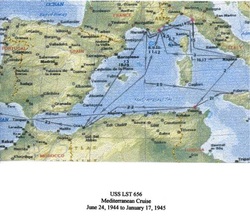
Mediterranean Cruise June 24, 1944 to January 17, 1945
1. June 24, 1944 underway from Little Creek, VA with LTC 1048, officers and men aboard.
Destination the Mediterranean Sea. July 14 anchored off Bizerte, Tunisia. (six days in and around Bizerte) Debarked LTC, took on ammunition and personnel for transport to next port.
2. July 21 underway from Bizerte, Tunisia, destination
Naples, Italy. July 23 arrived Bay of Nisida and off-loaded cargo and passengers. July 26 completed off-loading and anchored. (seventeen days in and
around Naples, Pozzouli, Biai, Salerno, and Castllamare) In the interval, boarded elements of the 45th Infantry Division - vehicles, men, and equipment in preparation for the invasion of Southern France.
3. August 12 underway for the south of France sailing though the Strait of Bonofacio, between Sardinia and Corsica. August 15 arrived at the Bay of Bougnon, lowered all the small boats
(LCVP's), and debarked assault troops for the invasion. Beached at "Blue Beach"
near Ste. Maxime, discharged army vehicles and personnel, and assembled at
rendezvous area.
4. August 16 picked up wounded and injured army personnel, underway for
Ajaccio, Corsica. Arrived Gulf of Ajaccio, transferred wounded troops ashore,
moored in anchorage, commenced loading French military personnel and vehicles.
5. August 18 underway in convoy for Delta Attack Area, Yellow Beach, Bay of
Bougnon, France. August 19 beaches, off-loaded troops and vehicles.
6. August 20 underway without cargo steaming for Gulf of Ajaccio, Corsica. Anchored August
21 ( three days in port). Loaded troops and cargo.
7. August 24 underway with troops and vehicles for Bay of Bougnon. Beached at Gulf of St. Tropez, France, unloaded troops and vehicles, retracted to rendezvous area.
8. August 26 underway without cargo for Oran, Algeria. Moored August 30 at Quai du Senegal,
Oran, Algeria and began loading French Army vehicles, refueled and took on fresh
water. (five days in port in and around Oran and Mers El Kebir, Algeria.)
9. September 5 underway in convoy for the south of France. September 10 unloaded cargo in Gulf of Topez and joined convoy destined for Oran, Algeria.
10. September 11 underway without cargo steaming to
Oran. Moored September 14 at Ouai du Senegal, Oran, Algeria. Loading troops and
vehicles.
11. September 15 underway in convoy for the south of France steaming
in gale force winds. September 20 beached on Green Beach near St. Raphael,
France unloaded troops and vehicles and anchored in Gulf of Frejus.
12. September 22 weighed anchor, empty of cargo. Destination Oran, Algeria.
September 25 moored at Berth 17 Quai du Senegal, Oran, Algeria. Loaded French
troops and vehicles then joined convoy bound for Marseille, France.
13. September 28 steaming for Marseille. October 1 anchored in Rade de Marseille.
remained anchored in full gale, holding position at anchor w/engines. October 3
elements of P-24 Thunderbird Air Wing. (three days in port.)
14. October 3 underway in convoy for Leghorn (Livorno), Italy. October 7
docked in Port Mediceo, Livorno, Italy unloaded air wing personnel and
equipment. *see note.
15. October 9 underway in convoy for Naples, Italy.
October moored at Pozzouli, Italy prepared ship for cargo of horses and mules.
(two days in port.)
16. October 13 underway for Nice, France with equine cargo
and handlers. October 15 moored in Nice and off-loaded "skinner" and cargo,
loaded US Army replacement troops. (two days in port.)
17. October 18 underway for Marseille, arrived and anchored in Rade de Marseille. Disembarked troops and loaded German POW's. 18. October 20 underway for Oran, Algeria. October 23
moored at Berth 19 Quai de Senegal, Oran off-loaded POW's and loaded French
colonial troops (Zuaves and Ghoums.)
19. October 25 underway in convoy for Marseille, heavy seas in Force 9 gale
out of northwest. October 29 entered Marseille Harbor, moored at Quai de La
Fraternite, Port Vieux to off-load French colonials and equipment.
20. October 30 underway empty of cargo for Palermo, Sicily and drydock, we're a mess!!
November 1 moored at Palermo. November 6 secured in drydock. Chipping paint,
scraping rust, painting decks and hull, sandblasting hull, welding on patches,
etc.,etc. (ten days in port)
21. November 11 underway for Bizerte, Tunisia with a barge in tow. November 13 unhooked barge and anchored in Lac du Bizerte. Busy work for about a month: took on some crew, some V/6 types for temporary duty, transferred some crew, refueled, gunnery practice. off-loaded residual tank deck
cargo, secured LCT 1142 for towing. (thirty days in and around Bizerte.)
22. December 12 underway for Oran, Algeria with LCT in tow. December 16
entered harbor of Oran, took on pilot, and moored. Cast off LCT, transferred
some crew, took on LST Repair Unit of 18 men for transportation, got underway
for Mers El Kebir anchorage. Forty nine officers and men reported aboard for
transport, swung ship and moored. (20 days in and around Oran.)
23. December 28 underway in convoy with 16 LSTs and 30 LCIs, destination Norfolk, VA. January 17
moored at Berth 36, Pier 3, NOB, Norfolk, VA Passengers debarked - end of
Mediterranean Cruise.
Notes: (1) The itinerary of the
"Mediterranean Cruise" was excerpted from a precis of the ship's log assembled
by Bill Deitz. An entry for October 8 noted that "(a couple of guys hitchhiked
up to Pisa where the front was right outside the city.)" Those two guys were
QM2/c Jim Ayer and S1/c Nick Caramenico
(2) Withdrawal from "Blue Beach" on
August 15 was involved. Unable to retract from beach even with aid of stern
anchor that was deployed during beaching. Started smoke generators to hide ship
and requested sea tugboat for assistance in retracting. Finally off the beach,
could maintain even keel only by filling forward port ballast tank. WT2/c Elmer
Gerdeman found gaping hole in the starboard tank below the waterline and
prevented pumpout. Speculation: On the way to the beach we hit a mine. Damage
repaired in drydock in Palermo, Sicily some ten weeks and many ports of call
later.
(3) This article and the map is a meld by James Ayer-QM. Of the precis
by Bill Deitz- QM and a trip map by Elmer Gerdeman - water tender - Neither of
which were connected - of the role played by U.S.S. L.S.T. 656
1. June 24, 1944 underway from Little Creek, VA with LTC 1048, officers and men aboard.
Destination the Mediterranean Sea. July 14 anchored off Bizerte, Tunisia. (six days in and around Bizerte) Debarked LTC, took on ammunition and personnel for transport to next port.
2. July 21 underway from Bizerte, Tunisia, destination
Naples, Italy. July 23 arrived Bay of Nisida and off-loaded cargo and passengers. July 26 completed off-loading and anchored. (seventeen days in and
around Naples, Pozzouli, Biai, Salerno, and Castllamare) In the interval, boarded elements of the 45th Infantry Division - vehicles, men, and equipment in preparation for the invasion of Southern France.
3. August 12 underway for the south of France sailing though the Strait of Bonofacio, between Sardinia and Corsica. August 15 arrived at the Bay of Bougnon, lowered all the small boats
(LCVP's), and debarked assault troops for the invasion. Beached at "Blue Beach"
near Ste. Maxime, discharged army vehicles and personnel, and assembled at
rendezvous area.
4. August 16 picked up wounded and injured army personnel, underway for
Ajaccio, Corsica. Arrived Gulf of Ajaccio, transferred wounded troops ashore,
moored in anchorage, commenced loading French military personnel and vehicles.
5. August 18 underway in convoy for Delta Attack Area, Yellow Beach, Bay of
Bougnon, France. August 19 beaches, off-loaded troops and vehicles.
6. August 20 underway without cargo steaming for Gulf of Ajaccio, Corsica. Anchored August
21 ( three days in port). Loaded troops and cargo.
7. August 24 underway with troops and vehicles for Bay of Bougnon. Beached at Gulf of St. Tropez, France, unloaded troops and vehicles, retracted to rendezvous area.
8. August 26 underway without cargo for Oran, Algeria. Moored August 30 at Quai du Senegal,
Oran, Algeria and began loading French Army vehicles, refueled and took on fresh
water. (five days in port in and around Oran and Mers El Kebir, Algeria.)
9. September 5 underway in convoy for the south of France. September 10 unloaded cargo in Gulf of Topez and joined convoy destined for Oran, Algeria.
10. September 11 underway without cargo steaming to
Oran. Moored September 14 at Ouai du Senegal, Oran, Algeria. Loading troops and
vehicles.
11. September 15 underway in convoy for the south of France steaming
in gale force winds. September 20 beached on Green Beach near St. Raphael,
France unloaded troops and vehicles and anchored in Gulf of Frejus.
12. September 22 weighed anchor, empty of cargo. Destination Oran, Algeria.
September 25 moored at Berth 17 Quai du Senegal, Oran, Algeria. Loaded French
troops and vehicles then joined convoy bound for Marseille, France.
13. September 28 steaming for Marseille. October 1 anchored in Rade de Marseille.
remained anchored in full gale, holding position at anchor w/engines. October 3
elements of P-24 Thunderbird Air Wing. (three days in port.)
14. October 3 underway in convoy for Leghorn (Livorno), Italy. October 7
docked in Port Mediceo, Livorno, Italy unloaded air wing personnel and
equipment. *see note.
15. October 9 underway in convoy for Naples, Italy.
October moored at Pozzouli, Italy prepared ship for cargo of horses and mules.
(two days in port.)
16. October 13 underway for Nice, France with equine cargo
and handlers. October 15 moored in Nice and off-loaded "skinner" and cargo,
loaded US Army replacement troops. (two days in port.)
17. October 18 underway for Marseille, arrived and anchored in Rade de Marseille. Disembarked troops and loaded German POW's. 18. October 20 underway for Oran, Algeria. October 23
moored at Berth 19 Quai de Senegal, Oran off-loaded POW's and loaded French
colonial troops (Zuaves and Ghoums.)
19. October 25 underway in convoy for Marseille, heavy seas in Force 9 gale
out of northwest. October 29 entered Marseille Harbor, moored at Quai de La
Fraternite, Port Vieux to off-load French colonials and equipment.
20. October 30 underway empty of cargo for Palermo, Sicily and drydock, we're a mess!!
November 1 moored at Palermo. November 6 secured in drydock. Chipping paint,
scraping rust, painting decks and hull, sandblasting hull, welding on patches,
etc.,etc. (ten days in port)
21. November 11 underway for Bizerte, Tunisia with a barge in tow. November 13 unhooked barge and anchored in Lac du Bizerte. Busy work for about a month: took on some crew, some V/6 types for temporary duty, transferred some crew, refueled, gunnery practice. off-loaded residual tank deck
cargo, secured LCT 1142 for towing. (thirty days in and around Bizerte.)
22. December 12 underway for Oran, Algeria with LCT in tow. December 16
entered harbor of Oran, took on pilot, and moored. Cast off LCT, transferred
some crew, took on LST Repair Unit of 18 men for transportation, got underway
for Mers El Kebir anchorage. Forty nine officers and men reported aboard for
transport, swung ship and moored. (20 days in and around Oran.)
23. December 28 underway in convoy with 16 LSTs and 30 LCIs, destination Norfolk, VA. January 17
moored at Berth 36, Pier 3, NOB, Norfolk, VA Passengers debarked - end of
Mediterranean Cruise.
Notes: (1) The itinerary of the
"Mediterranean Cruise" was excerpted from a precis of the ship's log assembled
by Bill Deitz. An entry for October 8 noted that "(a couple of guys hitchhiked
up to Pisa where the front was right outside the city.)" Those two guys were
QM2/c Jim Ayer and S1/c Nick Caramenico
(2) Withdrawal from "Blue Beach" on
August 15 was involved. Unable to retract from beach even with aid of stern
anchor that was deployed during beaching. Started smoke generators to hide ship
and requested sea tugboat for assistance in retracting. Finally off the beach,
could maintain even keel only by filling forward port ballast tank. WT2/c Elmer
Gerdeman found gaping hole in the starboard tank below the waterline and
prevented pumpout. Speculation: On the way to the beach we hit a mine. Damage
repaired in drydock in Palermo, Sicily some ten weeks and many ports of call
later.
(3) This article and the map is a meld by James Ayer-QM. Of the precis
by Bill Deitz- QM and a trip map by Elmer Gerdeman - water tender - Neither of
which were connected - of the role played by U.S.S. L.S.T. 656
After a nearly six month tour of duty in the Mediterranean (see LST Scuttlebutt, January,2008) during which it participated in the invasion of Southern France on August 15, 1944, the U.S.S. LST 656 left Oran, Algeria on New Year's Eve for the States to be refitted for the Pacific Theatre.
The crew, refreshed by a 30 day leave, were greeted by a new skipper, Lt. J.G.E.A. Doyenberg, who was promoted from Executive Officer to succeed Capt. FT. McCahill. The 656 sailed from New York City, LOT on deck, to the mine Depot of Yorktown, VA to take on a cargo of ammunition.
Sailing independently and now attached to the U.S. Pacific fleet, the 656 left Yorktown on
March 22, went through the Canal and up the California coast to San Diego arriving April 15. Two
days later, the 656 departed for Hawaii arriving at Pearl Harbor to unload her cargo of ammunition.
On May 21 she left Pearl in convoy for San Francisco arriving May 31 and was sent to Port Chicago Mine Depot for another load of ammunition. She then sailed on June 21 for Kaneohe Bay, Hawaii where she arrived June 22.
On July 6 the 656 sailed in convoy for Eniwetok in the Marshall Islands, arriving July 18. A week later she left for Guam in the Marianas, arriving July 30 at Apra Harbor where she off loaded her cargo of ammunition. The 656 remained in Apra Harbor awaiting orders when on August 6 came the news that an atomic bomb had been dropped on Hiroshima, a city in Japan! Expectations immediately arose that perhaps the 656 would not, as had been expected, be prepared for an invasion somewhere. These expectations were encouraged by the news of a second atomic bomb being dropped on Nagasaki on August 9. Just five days later, came the news of Japan's surrender!
With the war over, LST 656 began a period where she was engaged in ferrying all kinds of people and material over the rim of the Pacific. It began on August 19 when she set sail for Saipan carrying 166 Marines with five officers who were off loaded the next day. Then on August 29 the 656 was ordered to proceed to Okinawa to load a cargo of 167 Koreans and their belongings who have been in forced labor in Okinawa to take them to their homeland. We did just that arriving in Jinsen, Korea, September 17.
On September 23 it was back to Okinawa, only to be diverted by what turned out to be a rather tame (if there is such a thing) typhoon. In any case, we were back to Purple Beach to load an Army contingent of 11 officers and 181 enlisted men with their motorized equipment finishing loading on October 3. The 656 got underway to join a convoy for Korea October 5 only to be ordered to return to Hagushi Bay. Three days later Capt. Dovenberg received orders to go to sea to the area assigned to LST's according to Plan X-ray, the Typhoon Evacuation Plan. Capt. Doovenberg asked permission to offload Army the Army unit, but permission was denied.
So it was off to our assigned area to the east of the island and this typhoon was not a "tame" one. By
2000 hours on October 8 the wind was at force 5; by 2200 hours it was at force 6; at 2400 hours force 7; by 0800 hours October 9 the wind was at force 8; at 1300 hours it hit force 9; at 1500 hours force 10; at 2100 hours force 11 and at 2400 hours the wind hit force 12. It remained at force 12 until 0600 hours before beginning to abate. By noon on October 10 the wind was down to force 5 and the 656 headed back to Hangushi Bay with one load of seasick army personnel.
Finally, on October 13 we got underway for Jinsen, Korea, where we unloaded the army unit
and got underway for Saishu Yo where on October 24 we loaded 1400 Japanese POW's and their
guards for shipment to Sasebo, Japan. After discharging the POW's, and refueling at the tanker
U.S.S. Aucilla, it was back to Hagushi Bay where on November 1 our Skipper, Lt. Dovenberg, left for
home and was succeeded by Lt. J.G.J.E. Hannan.
At Purple Beach we loaded another unit of 11 officers and 230 enlisted men and their equip-
ment for Jinsen, Korea, arriving November 10. After unloading, it was back to Hagushi Bay, this
time to load 125 Okinawans and their gear to ferry them over to Buckner Bay where we took on 38
Army enlisted men and five officers, plus a shipment of mail and on November 27 set sail for Shang-
hai, China.
Arriving on the 29th, we picked up our pilot and tied up at the Wayside Wharf. Happily, we
remained there until December 6 when we took aboard 74 passengers for Tsing Tao, China. After
dropping off our passengers there, we loaded 116 of our men and six officers for passage to Taku,
China. On December 14 we tied up alongside U.S.S. Tutuila where we off loaded our passengers
and a load of Prestone we had taken on. We then shifted to the starboard side of LST 49 to offload
our shipment of mail. Next day we moved to the Mole of Taku to offload the remainder of the mail
shipment.
On the 17th of December while enroute from Taku to Okinawa, the 656 ran into a ferocious
gale out of the northwest. At 0800 hours the wind was at force 7; it increased to force 8 at 0900
hours and to force 9 at 1000 hours. The storm set us down toward the rocks on the Kwantung Pen-
insula making it necessary to use the engines to bring her around from course 110 degrees at first to
045 and then to 000. Thankfully the storm abated and we resumed course arriving at Buckner Bay
December 22. This episode was more eventful then ordinary since we had damaged our starboard
screw earlier by hitting a reef in Okinawa.
On December 28 we loaded another shipment of mail for Shanghai and were soon there
unloading on January 2. On January 10 we shifted to a new mooring and began taking on a ship-
ment of Japanese "repatriates" getting underway for Sasebo on January 12 in company with LST's
1059 and 654. It was nice to have company! After unloading the "repatriates", we got underway for Shanghai January 14, this time in company with LSTS 1008, 654, 862, 935 and 1059. By January
18 we were back in the Woosung Anchorage and by 1811 hours were moored bow and stern in the
river. On January 26 while still moored as before, the ship was greeted by Lt. McGrath, Command-
ing Officer of LS1589, and a party attached to Task Unit 78, 12, 21. The inspection was completed
at 10:55 and by 11:57 LST 656 was moored at the New Engineering and Shipbuilding Works. On
January 27 we were underway for drydock at 0826 and secured at 0841. The 656 was in drydock
until January 31 for repairs, receiving a new starboard shaft, among other things.
On February 1 LST 656, her repairs completed, greeted a new Skipper, Lt. J. G. M. L. Tusker
who succeeded Lt J G. Hannan. That same day she began loading 1.072 Japanese "repatriates"
for shipment to Sasebo. We arrived there February 4, completing unloading at 12:30 hours. On
February 6 the 656 was enroute back to Shanghai, this time in company with LSTs 559, 960, 1060,
596 and 952.
On February 8 at 15:59 the 656 dropped hook in the Woosung Quarantine Anchorage and on
February 11 was underway up the Whangpoo where she moored at the China Merchants Eastern
Wharf at 16:30 hours. While moored there at 0850 hours on February 13 ten enlisted crew mem-
bers, including William T. Deitz, QM1/c, the author of this piece, were transferred from LST 656 to
USS Orvietta for reassignment at San Francisco, California.
LST 656 continued her service in China until late May 1946. The ship was decommissioned
May 29 and transferred to the State Department for disposition that same day. She was struck from
the Navy list on 3 July, 1946. LST 656 earned one battle star for World War II service.
* A personal note. The author, William T Deitz, served on the crew of LST 656 from its launching
February 18, 1944 at Ambridge, PA, where she was built at the American Bridge Company through-
out her service in the Europe-Africa-Middle East Theater and the Pacific Theater until his reassign-
ment at Shanghai to return to the U.S. for discharge. In that time he advanced from Seaman 2/c
(QM Striker) to QM 1/c. The author is profoundly grateful for the excellence in the ship's construc-
tion that permitted her to survive one of the most destructive typhoons ever recorded. And, during
the invasion of Southern France, in spite of having a hole blown in her hull the 656 continued on as if
nothing had happened. She was a fine ship and a proud testament to the men and women who built
her, the men who served on her and the thousands of men she carried, all safe and sound to their
destinations.
The crew, refreshed by a 30 day leave, were greeted by a new skipper, Lt. J.G.E.A. Doyenberg, who was promoted from Executive Officer to succeed Capt. FT. McCahill. The 656 sailed from New York City, LOT on deck, to the mine Depot of Yorktown, VA to take on a cargo of ammunition.
Sailing independently and now attached to the U.S. Pacific fleet, the 656 left Yorktown on
March 22, went through the Canal and up the California coast to San Diego arriving April 15. Two
days later, the 656 departed for Hawaii arriving at Pearl Harbor to unload her cargo of ammunition.
On May 21 she left Pearl in convoy for San Francisco arriving May 31 and was sent to Port Chicago Mine Depot for another load of ammunition. She then sailed on June 21 for Kaneohe Bay, Hawaii where she arrived June 22.
On July 6 the 656 sailed in convoy for Eniwetok in the Marshall Islands, arriving July 18. A week later she left for Guam in the Marianas, arriving July 30 at Apra Harbor where she off loaded her cargo of ammunition. The 656 remained in Apra Harbor awaiting orders when on August 6 came the news that an atomic bomb had been dropped on Hiroshima, a city in Japan! Expectations immediately arose that perhaps the 656 would not, as had been expected, be prepared for an invasion somewhere. These expectations were encouraged by the news of a second atomic bomb being dropped on Nagasaki on August 9. Just five days later, came the news of Japan's surrender!
With the war over, LST 656 began a period where she was engaged in ferrying all kinds of people and material over the rim of the Pacific. It began on August 19 when she set sail for Saipan carrying 166 Marines with five officers who were off loaded the next day. Then on August 29 the 656 was ordered to proceed to Okinawa to load a cargo of 167 Koreans and their belongings who have been in forced labor in Okinawa to take them to their homeland. We did just that arriving in Jinsen, Korea, September 17.
On September 23 it was back to Okinawa, only to be diverted by what turned out to be a rather tame (if there is such a thing) typhoon. In any case, we were back to Purple Beach to load an Army contingent of 11 officers and 181 enlisted men with their motorized equipment finishing loading on October 3. The 656 got underway to join a convoy for Korea October 5 only to be ordered to return to Hagushi Bay. Three days later Capt. Dovenberg received orders to go to sea to the area assigned to LST's according to Plan X-ray, the Typhoon Evacuation Plan. Capt. Doovenberg asked permission to offload Army the Army unit, but permission was denied.
So it was off to our assigned area to the east of the island and this typhoon was not a "tame" one. By
2000 hours on October 8 the wind was at force 5; by 2200 hours it was at force 6; at 2400 hours force 7; by 0800 hours October 9 the wind was at force 8; at 1300 hours it hit force 9; at 1500 hours force 10; at 2100 hours force 11 and at 2400 hours the wind hit force 12. It remained at force 12 until 0600 hours before beginning to abate. By noon on October 10 the wind was down to force 5 and the 656 headed back to Hangushi Bay with one load of seasick army personnel.
Finally, on October 13 we got underway for Jinsen, Korea, where we unloaded the army unit
and got underway for Saishu Yo where on October 24 we loaded 1400 Japanese POW's and their
guards for shipment to Sasebo, Japan. After discharging the POW's, and refueling at the tanker
U.S.S. Aucilla, it was back to Hagushi Bay where on November 1 our Skipper, Lt. Dovenberg, left for
home and was succeeded by Lt. J.G.J.E. Hannan.
At Purple Beach we loaded another unit of 11 officers and 230 enlisted men and their equip-
ment for Jinsen, Korea, arriving November 10. After unloading, it was back to Hagushi Bay, this
time to load 125 Okinawans and their gear to ferry them over to Buckner Bay where we took on 38
Army enlisted men and five officers, plus a shipment of mail and on November 27 set sail for Shang-
hai, China.
Arriving on the 29th, we picked up our pilot and tied up at the Wayside Wharf. Happily, we
remained there until December 6 when we took aboard 74 passengers for Tsing Tao, China. After
dropping off our passengers there, we loaded 116 of our men and six officers for passage to Taku,
China. On December 14 we tied up alongside U.S.S. Tutuila where we off loaded our passengers
and a load of Prestone we had taken on. We then shifted to the starboard side of LST 49 to offload
our shipment of mail. Next day we moved to the Mole of Taku to offload the remainder of the mail
shipment.
On the 17th of December while enroute from Taku to Okinawa, the 656 ran into a ferocious
gale out of the northwest. At 0800 hours the wind was at force 7; it increased to force 8 at 0900
hours and to force 9 at 1000 hours. The storm set us down toward the rocks on the Kwantung Pen-
insula making it necessary to use the engines to bring her around from course 110 degrees at first to
045 and then to 000. Thankfully the storm abated and we resumed course arriving at Buckner Bay
December 22. This episode was more eventful then ordinary since we had damaged our starboard
screw earlier by hitting a reef in Okinawa.
On December 28 we loaded another shipment of mail for Shanghai and were soon there
unloading on January 2. On January 10 we shifted to a new mooring and began taking on a ship-
ment of Japanese "repatriates" getting underway for Sasebo on January 12 in company with LST's
1059 and 654. It was nice to have company! After unloading the "repatriates", we got underway for Shanghai January 14, this time in company with LSTS 1008, 654, 862, 935 and 1059. By January
18 we were back in the Woosung Anchorage and by 1811 hours were moored bow and stern in the
river. On January 26 while still moored as before, the ship was greeted by Lt. McGrath, Command-
ing Officer of LS1589, and a party attached to Task Unit 78, 12, 21. The inspection was completed
at 10:55 and by 11:57 LST 656 was moored at the New Engineering and Shipbuilding Works. On
January 27 we were underway for drydock at 0826 and secured at 0841. The 656 was in drydock
until January 31 for repairs, receiving a new starboard shaft, among other things.
On February 1 LST 656, her repairs completed, greeted a new Skipper, Lt. J. G. M. L. Tusker
who succeeded Lt J G. Hannan. That same day she began loading 1.072 Japanese "repatriates"
for shipment to Sasebo. We arrived there February 4, completing unloading at 12:30 hours. On
February 6 the 656 was enroute back to Shanghai, this time in company with LSTs 559, 960, 1060,
596 and 952.
On February 8 at 15:59 the 656 dropped hook in the Woosung Quarantine Anchorage and on
February 11 was underway up the Whangpoo where she moored at the China Merchants Eastern
Wharf at 16:30 hours. While moored there at 0850 hours on February 13 ten enlisted crew mem-
bers, including William T. Deitz, QM1/c, the author of this piece, were transferred from LST 656 to
USS Orvietta for reassignment at San Francisco, California.
LST 656 continued her service in China until late May 1946. The ship was decommissioned
May 29 and transferred to the State Department for disposition that same day. She was struck from
the Navy list on 3 July, 1946. LST 656 earned one battle star for World War II service.
* A personal note. The author, William T Deitz, served on the crew of LST 656 from its launching
February 18, 1944 at Ambridge, PA, where she was built at the American Bridge Company through-
out her service in the Europe-Africa-Middle East Theater and the Pacific Theater until his reassign-
ment at Shanghai to return to the U.S. for discharge. In that time he advanced from Seaman 2/c
(QM Striker) to QM 1/c. The author is profoundly grateful for the excellence in the ship's construc-
tion that permitted her to survive one of the most destructive typhoons ever recorded. And, during
the invasion of Southern France, in spite of having a hole blown in her hull the 656 continued on as if
nothing had happened. She was a fine ship and a proud testament to the men and women who built
her, the men who served on her and the thousands of men she carried, all safe and sound to their
destinations.
LST656 Reunion Pictures
Want your own copy?
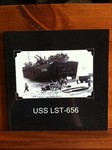
In 2010 a little Creative Memories booklet was compiled and printed.
It is 27 pages and contains the pictures and information from this web
page.
Soft cover costs:
Hardcover costs:
Discounts for 10 or more.
To order your own copy contact Tina at [email protected].
It is 27 pages and contains the pictures and information from this web
page.
Soft cover costs:
Hardcover costs:
Discounts for 10 or more.
To order your own copy contact Tina at [email protected].
